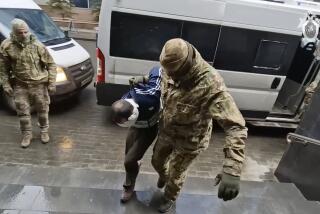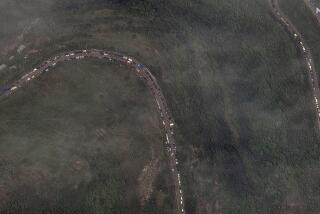National Agenda : Struggling With the ‘Tajik Problem’ : Russians still prop up the Central Asian republic, but they are also fleeing it in record numbers.
- Share via
PYANDZH, Tajikistan — From the watchtower at Border Post 12, a sentry scans the arid plain. A mile away on the horizon, shimmering in the afternoon heat, is the Pyandzh River and beyond it Afghanistan.
“The most volatile border in the world,” said an aide to Tajikistan’s head of state.
Border Post 12--in fact, the entire Tajik side of the 750-mile frontier--is commanded by Russians. Once the Soviet Union’s border, it is too vital to Moscow’s sense of security to be abandoned to the newly independent and warring Tajiks.
“If we leave here, the war will follow us home,” said Sgt. Vladislav N. Rodinov, 19, the Russian who maintains the alarm system that detects Tajik guerrillas from across the river as they approach a 10-foot-high border fence.
Said Gen. Grigory A. Besmertny, “This border is Russia’s border.”
Three years after the Soviet Union broke up, Russians are still masters of this Central Asian republic, more so than anywhere else in their former empire. They prop up the Tajik government, supply its currency, dictate its foreign policy, bear the brunt of its guerrilla war. Russian diplomats help draft speeches for Tajik President Imomali Rakhmonov.
For all Moscow’s clout, however, Tajikistan has become unbearable for most of the Russians who colonized, urbanized and industrialized it in Soviet days. In numbers exceeding those from any other former Soviet republic, the ethnic Russians are fleeing war, insecurity, economic hardship and nascent Tajik nationalism.
Moscow’s conflicting neo-colonial impulses--to control this little country even as Russians abandon it--have deepened Tajik resentment.
In effect, Russian policy has reduced Tajikistan and its 5.5 million people to a military buffer protecting Russia from the chronic clan warfare, gun running and drug smuggling that spill over from unruly Afghanistan, the violent arena that humbled the Soviet army in the 1980s.
Even as Russian diplomats join in efforts to make peace, many here believe that Russian military involvement has escalated the civil war, which pits a ruling regional clan of Tajik Communists and their 8,000-member army against 5,000 guerrillas from rival Tajik clans led by democrats and Muslims. More than 20,000 people have died in two years of fighting.
“Tajikistan was a beautiful, warm and friendly part of the world--always enough food and never any bad words from the Tajiks until now,” said Antonina A. Sofyanov, a Russian who came to this country in 1939 at age 12.
Now 67 and fretful, she is trying to sell her garden apartment and vineyard in the best district of Dushanbe, the Tajik capital, for $1,000 in rubles, about what it will cost to ship her belongings to Russia by rail.
Rubles are in such short supply that Sofyanov, still employed as a bookkeeper on the Tajik state payroll, has not received her salary since February. Her Russian husband last collected a monthly retirement pension in May.
The couple decided to emigrate after she got up one day at 3 a.m. to stand in line for bread, only to have a Tajik insult her. “Go away and our life will get better,” he snarled at her. “All our problems are because of you Russians.”
“The Russians built this country,” Sofyanov said, recalling the incident. “Now we have to go.”
Indeed, where a Muslim village stood 70 years ago, Russian emigrants founded the Tajik capital. They constructed one of the world’s biggest aluminum plants, fueled it with Central Asia’s most potent hydroelectric station and diverted the water through tunnels to turn the arid landscape green.
“Our first doctors were Russians, our first engineers, drivers, communications workers, scientists, writers, composers,” said Sultan Mirzoshoyev, President Rakhmonov’s chief of staff.
The country remained so dependent on Russians that their exodus is crippling the economy and public services.
Of the 500,000 Russians in Tajikistan before the civil war began in 1992, at least 320,000 have left, according to the Russian Embassy in Dushanbe.
The exodus parallels the post-Soviet migration home of Russians from all the new neighboring republics and is the largest reported from any of them.
Many of the remaining 180,000 Russians here simply have nowhere to live or work in their homeland, which has a housing shortage and growing unemployment itself. To raise money for the next week’s food, they set up informal sidewalk bazaars to sell their clothing and other possessions.
Outside the fortress-like headquarters of the Russian army’s 201st Motorized Rifle Division in Dushanbe, a ragged Russian veteran of World War II was stooping by a garbage dump, collecting severed fish heads in a plastic bag.
The headquarters itself is a thriving imperial enclave within a poor colony. The Russian army, with its large complement of border troops here, is in the midst of a buildup and is one of the few institutions in Tajikistan that pays salaries on time.
Russia has 17,000 border troops here, backed by 6,500 soldiers of the 201st Division who guard factories, dams and other guerrilla targets.
Having helped the Rakhmonov clan seize the government from its rivals two years ago, the Russian army now portrays itself as a neutral broker and defender of the border, striving to win U.N. endorsement and funding as a peacekeeping force.
Privately, officers say their real mission here is to preserve Russian hegemony.
“Whoever comes to power in Tajikistan must bow to us,” said a Russian commander in Dushanbe.
But other voices in Moscow are warning that Russia’s patronage--$70 million this year alone--is not unlimited.
The Russian Economics Ministry in Moscow, after first welcoming Rakhmonov’s decision to stay in the “ruble zone,” has balked at the high cost of supporting Tajikistan and set conditions that may force Dushanbe to issue its own currency.
Worried that the military buildup is not working, Russia’s Foreign Ministry successfully pressured Rakhmonov to start peace talks with the opposition. Although the talks last month produced a temporary cease-fire, a final political settlement seems far away.
“I don’t think the Russians particularly want to be the colonial masters of Tajikistan,” said a diplomat in Dushanbe. “I think they see Tajikistan as a black hole. They have a commitment here that they would rather not have. . . .”
Moscow’s ambivalence makes the shrinking Russian community here all the more uneasy with its Tajik neighbors.
Vladimir P. Kondur, a Russian scientist who has lived in Tajikistan for 32 years, described with dismay how nine of his 11 Russian neighbors have moved out of a Dushanbe apartment building, giving way, he said, to Tajiks who play loud music and let their children defecate in the hallways. “They don’t belong here. They’re not cultured,” he insists.
For all the complaints, Russian civilians have not suffered nearly as much as Tajiks in the war. They are no longer targeted or openly threatened by the guerrillas. In fact, opposition spokesmen say they now accept the need for long-term Russian border protection and other assistance.
But even as they worry about the Russian exodus, Tajik authorities have resisted proposals to let Russians take dual citizenship, to restore Russian as an official language and to give Russians representational quotas in Parliament.
Sergei L. Loiko, a reporter in The Times’ Moscow Bureau, contributed to this article.
Rich History
The Republic of Tajikistan, which declared independence from the Soviet Union in 1991, is in a region that has changed hands many times.
The Tajiks are descendants of Iranian-speaking people who entered Central Asia as early as 2000 BC. They were incorporated into the Persian Empire and later the empire of Alexander the Great. In the 10th Century, Turkic-speaking peoples overran Central Asia. Many Tajiks were assimilated then, with their culture surviving mainly in the mountains.
Later, the Tajiks were brought under control of the Emirate of Bukhara, then Afghanistan in the 18th Century and finally the Russian Empire in the 1860s.
After the 1917 Russian Revolution, the Red Army claimed most of the territory of modern Tajikistan. In 1922-23, the Tajiks led an unsuccessful revolt against Communist rule.
SOURCE: Russia, Eurasian States and Eastern Europe, 24th edition
More to Read
Sign up for Essential California
The most important California stories and recommendations in your inbox every morning.
You may occasionally receive promotional content from the Los Angeles Times.













